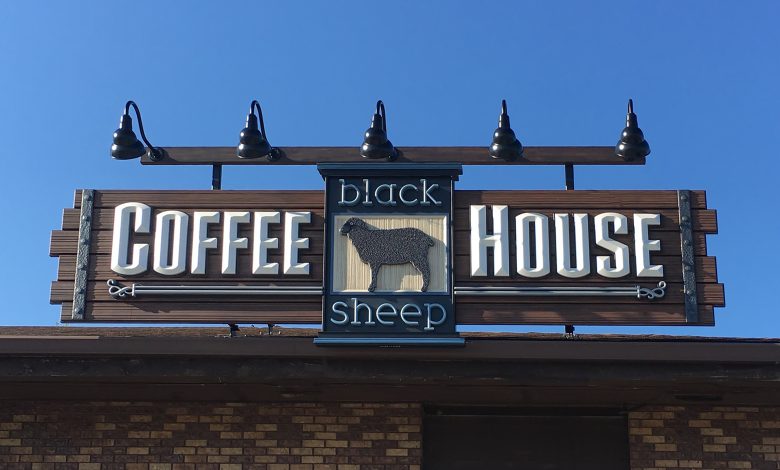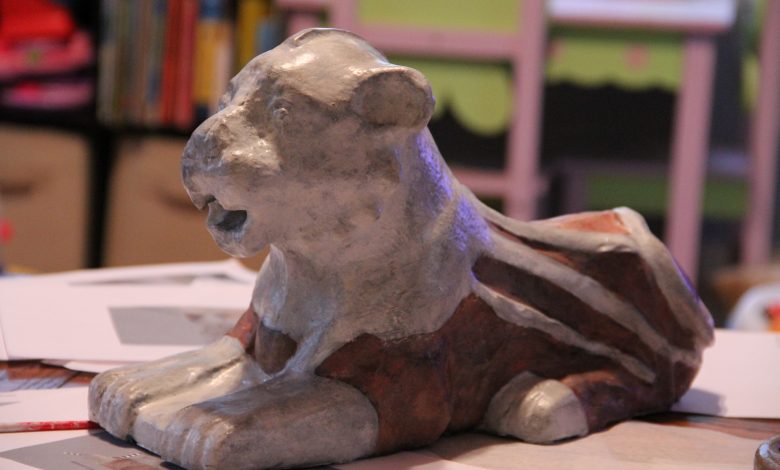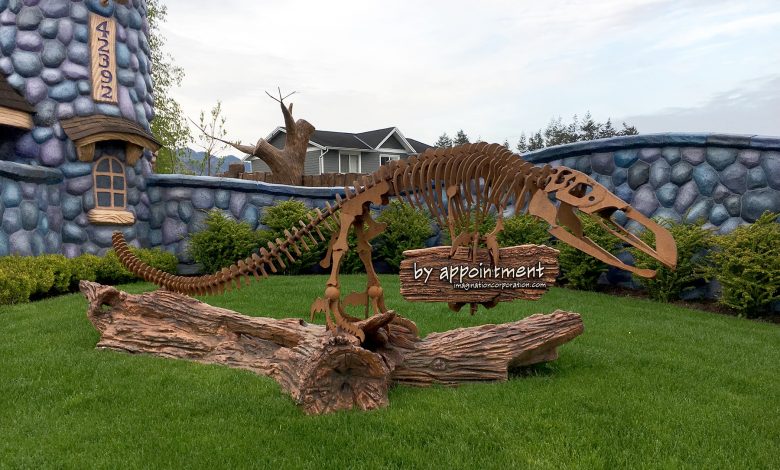Unique CNC Router Applications
Thinking outside the box with your router
Dan Sawatzky’s house is the best advertisement for his business, Imagination Corporation in Chilliwack, British Columbia, Canada. The house looks almost like a hobbit hole, with a large round window in front and the pillars holding up the roof looking like old tree trunks. What looks like a half wall of river stones surrounds the house. But the trees and the wall were all carved using a CNC router.
Imagination Corporation considers itself a sign shop but it operates under a different business model than its competitors.
“We turn away nine out of 10 people who come to our door. The only ones we are interested in are the ones that have the best projects, the most crazy projects,” says Sawatzky, owner and founder of Imagination Corporation.
He and his team ask five questions before taking on any project: Will it be fun? Does the customer trust us? Do we have enough time? Will it bring us closer to work we want to do in the future? Is there enough money?
“We only want to be known for work we want to do,” he says. He appreciates the clients who give him free rein to be creative and have a decent budget for the project so he doesn’t have to limit his imagination.
He uses 30-lb. Precision Board or higher for all of the company’s projects, which is much denser than the industry standard of 15- to 20-lb. board. The big reason is that it is stronger than the lighter weight high-density urethane.
The company puts a tremendous amount of work into its pieces. Sawatzky says lighter weight HDU is so fragile, it would crumble under the amount of detail that he and his team put into each piece.
Most of the company’s cutting is done on a 3-axis MultiCam router, which “allows us to work quickly and with higher precision, and that’s important,” he says.
Most of his competitors use the machine and hand work to make a project look like it was done by machine. Sawatzky wants his work that comes off the router to look like it was done by hand.
“We purposely add texture so it looks hand done. That adds tremendous value in today’s world. I work very quickly, but the router will do it five times faster. It will do all of the grunt work so it allows us to put in the hand work afterwards,” he says.
Imagination Corporation paints all projects by hand and also does sculpting with sculpting epoxy when necessary.
It uses its CNC plasma to incorporate brackets into its designs.
“Everything tells the story, from the brackets all in. We are storytellers. Everything we do we put a story to it and tell that story visually,” he says.
For the pictured Copper Crown, the sign company showed how well the metal pieces were integrated into the carved signs. The leafy bracket was plasma cut steel and the structure of it goes into the actual sign as well as the mounting plates on the wall.
The signs the company did for a themed inn incorporate plasma-cut steel as well. In the Northstar sign, you see a black line behind the compass rose. That structure goes through the sign. Some of it is exposed and some is not, he says. The Under Hill sign also has a steel structure that goes through it. Elements of the key were cut with the plasma cutter. The leafy bracket and big lock are also steel.
“That becomes indestructible and easily mounted because there is a steel structure in it,” Sawatzky says.
CNC routers are being used for everything from 3D sculptures and ice sculptures to set making for movie or theater production, embossing designer handbags and precision cutting for the aerospace industry, says Josh Hooley, digital marketing specialist at AXYZ International, a manufacturer of CNC routers.
“It provides businesses with a clear competitive advantage over those who rely on more traditional/manual methods,” he says. “A CNC allows businesses to ramp up their operations, increasing productivity, cutting costs and competing for projects/contracts they wouldn’t have previously been able to.”
Roger Cox, owner and creative director of House of Signs in Frisco, Colorado, says that his work is in high demand both locally and internationally.
“It has to do with the aesthetics of the designs we create and the uniqueness of the way we approach and build signs. It is not really seen with too many companies,” he says.
The company invested in its first CNC machine back in 2000. At that point in time, Cox was focusing on creating visually dynamic carved signs and was spending a lot of time hand-carving everything.
“The end result was fantastic but the efficiency was very low,” he says.
The CNC router “opened up a whole new world, specifically some years later when we were integrating 3-dimensional software into our work, that essentially becomes yet another realm that again could have been achieved by hand but would have been that much more labor-intensive to create a 2.5D or 3D piece,” Cox says.
Most sign shops use a 3-axis router, meaning it can mill half of a cylinder or half of a full-contoured sphere because it moves front to back, side to side and up and down. The 3-axis and 4-axis machines provide the most amount of detail so that’s why most sign shops stick with these two routers.
To create some of the more ambitious projects and signage, House of Signs spends a lot of time up front working in dimensioning software to make sure the cuts are in the right place and the different layers take shape before it is even sent to the router.
“The level of detail we are asking our CNCs to do is really quite phenomenal,” he says.
House of Signs is working on a carving with some blue jays in it currently. It is milling the birds with a 1/16 bit, “which is about as big as a sewing needle you use for canvas,” he says. “The smaller the bit the more detail you get but the longer the mill time you have also. It is not uncommon for some of our detailed pieces with a small bit to run 24 to 36 hours straight on one piece.”
The company still uses its original Gerber 3-axis router with single bit capability, but many of its bigger projects have moved to its new MultiCam 3-axis machine, which has a six-tool docking station.
Cox says he really pushed the limits of what the CNC router could do when it created a vintage gas pump for a sign competition.
“Our goal was not only to produce a piece that would really wow the audience and judges but we wanted to really showcase the capabilities of our machine. It is truly amazing what we created out of a four-sided piece,” he says.
Because the company is located in Frisco, which is by all of Colorado’s biggest ski resorts, its work is seen by people from all over the world.
“Our signs tell a story. They leave a lasting impression. That’s the whole point. To give our clients these unique stamps that help their business grow and set themselves apart,” he adds.
Lindsay Neathawk, owner and designer at Neathawk Designs in Williamstown, Massachusetts, started off using a CNC router as a hobby. She bought a 2×2′ Shark CNC, which she outgrew in two months. She saved up to buy a bigger CNC a year later. She purchased a ShopBot 3-axis machine in 2011 and has been using it primarily to carve signs.
Neathawk says she is always trying to push the envelope with her designs, always “trying to take the ordinary and make it unique and extraordinary.”
Along with signs, Neathawk is making a name for herself in the museum replica business. She was commissioned to make her first museum replica for the Harvard University Semitic Museum. The museum had one of a pair of the Nuzi lions, which were lion sculptures discovered in northeastern Iraq. The other one was on loan from the University of Pennsylvania.
“They had the original lion but it’s so heavy and it was also frail. They didn’t want to send it on display but also needed the pair to it,” she says.
They commissioned her to take the 3D computer models that had been done of both lions and carve two sets of exact replicas. Her second museum piece was for Yeshiva University and was a scene from the Arch of Titus. The scene was 6½’ tall and 12.5′ long and was carved from 32 sheets of 2″ foam glued together like a jigsaw puzzle, with no seams. It also had to be able to stand up and travel.
“There was a scan done in 2012 of the actual panel in Rome and from there, those scans were turned into CAD files by this company I worked with on this project, Learning Sites,” Neathawk says.
Since her cutting table is only 4×8, she cut the design into 4′ sections and then she used her program to slice it from there. The project took 49 days to complete.
“It was a lot of fun but my brain hurt. It was the most complex thing I’ve ever done. Before that I thought the Nuzi lion was the most complex thing,” she says.
Neathawk says that she works backward on projects.
“In marketing and stuff, you figure out what the end result will be and work backward, always. That’s how I work it usually, especially anything that’s complex. Even simple signs can be complex,” she adds.
Like House of Signs in Frisco, the owners of Appalachian Sign in Boone, North Carolina, take advantage of the resort area they live in to make a name for themselves in the carved signage business. Located at the tail end of the Appalachian Mountains, near Appalachian State University, Laura Shoemaker and Sarah Evans use their ShopBot to make traditional and non-traditional signage.
One of the projects they are most proud of is when they were asked to skin the façade of the Hope Pregnancy Center. The architect that commissioned them for the job wanted to create the illusion of a typical municipal building with the name of the business debossed on the front of it. Shoemaker and Evans carved the name into HDU and made it look as if it was part of the architecture of the building as opposed to a sign, Shoemaker says.
“It makes it sort of understated, not a subliminal message, but it works on a couple of levels,” she says.
The architects refaced the old masonry building with rock. Appalachian Sign did its part with HDU and much of it trimmed out in wood.
The shop owners love to use their CNC on projects as opposed to sand blasting or more traditional ways of doing things because they can break someone’s logo or artwork into different elements.
“There are so many tool paths you can run on any kind of lettering or logos. So many ways you can carve it in, raise it or model it. We try to look at all the individual elements and decide how is this going to be awesome and we really try. Of course you are working with customers, budgets and timelines so you have to balance everything. You can’t always go over the top. We try to go above and beyond and try to make their sign as nice and cool as it can be by taking all the different parts and doing it how we feel it should be done,” Shoemaker says.
Most of the company’s signs are sculptural, with different levels of shadow, texture and color.
“We fortunately live in a resort area where it is appreciated to have cool signage. It is valued because it is part of our identity and our community,” she says. “It is important for us to have signage that is reflective of the interesting place we live and the businesses that are here. Everybody has huge personalities. We have a tourist economy.”




